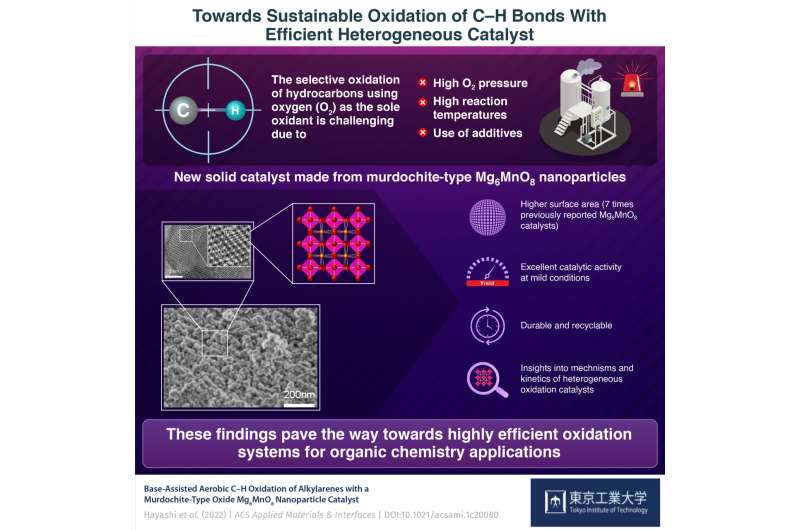
In the chemical industry, the selective cleavage and oxidation of carbon–hydrogen (C–H) bonds, called “oxidative C–H functionalization” is an essential step in the production of many solvents, polymers, and surfactants, as well as intermediate compounds for agrochemicals and pharmaceuticals. Ideally, one would want to use oxygen (O2) as the only oxidant in this process to avoid using more expensive and environmentally taxing substances, such as hydrogen peroxide (H2O2), chlorine (Cl2), or nitric acid (HNO3).
However, using O2 as the oxidant entails some unresolved problems. While some progress has been made in the field of recoverable and reusable catalysts, most heterogeneous systems require high reaction temperatures, high O2 pressures, or the use of toxic additives. In turn, this cripples the scope of potential applications, scalability, and efficiency of these catalytic systems.
Against this backdrop, a team of scientists from Tokyo Tech, led by Associate Professor Keigo Kamata, recently found a promising catalyst for oxidative C–H functionalization. As explained in their paper published in ACS Applied Materials & Interfaces, they inferred that isolated manganese (Mn) species fixed in a crystalline matrix could constitute a high-performance heterogeneous catalyst even at mild reaction conditions, based on previous knowledge.
Accordingly, they investigated the catalyst murdochite-type Mg6MnO8, a rock salt structure of magnesium oxide (MgO) with one eighth of the Mg2+ ions replaced with Mn4+ ions and another eighth replaced with vacancies, resulting in a crystal with Mn ions and vacancies orderly occupying alternating layers. Using a cost-effective sol–gel method aided by malic acid, the team prepared Mg6MnO8 nanoparticles with a very high surface area. Dr. Kamata elaborates: “The specific surface area of our Mg6MnO8 catalyst was 104 m2/g, about seven times higher than that of Mg6MnO8 synthesized using previously reported methods.”
The researchers also demonstrated, through numerous experiments, that their Mg6MnO8 nanoparticles could efficiently catalyze the selective oxidation of C–H of various alkylarene compounds even under mild reaction conditions, namely 40°C and atmospheric pressure. The yield of the final products was also higher than that obtained using existing Mn-based catalysts. To top things off, the Mg6MnO8 nanoparticles could be easily recovered via filtration and then reused without any apparent loss in catalytic activity after multiple cycles.
Finally, the team sought to understand why their proposed catalyst performed so well through a series of kinetic and mechanistic studies. They concluded that the isolation of redox sites (Mn species, in this case) in a crystalline base matrix (MgO) was a particularly important feature to achieve oxidative C–H functionalization using O2 at mild conditions.
Satisfied with the results and their findings, Dr. Kamata speculates: “Our approach constitutes a promising strategy for the development of highly efficient heterogeneous oxidation systems with wide substrate scopes.”
More information:
Eri Hayashi et al, Base-Assisted Aerobic C–H Oxidation of Alkylarenes with a Murdochite-Type Oxide Mg6MnO8 Nanoparticle Catalyst, ACS Applied Materials & Interfaces (2022). DOI: 10.1021/acsami.1c20080
Journal information:ACS Applied Materials and Interfaces
Provided by
Tokyo Institute of Technology

READ MORE
Ten Science Stories You Should Have Read
Feedloader (Clickability) Is your office rather empty this week? Looking for something to read to [...]
First nanoscale direct observation of how glass transforms into liquid at increasing temperature
Surface undulation patterns and their modeling via finite element simulations. a, Schematic showing the growth [...]
Study reveals how humanity could unite to address global challenges
Credit: CC0 Public Domain New research led by the University of Oxford has found that [...]
New Species of Beetle Found in 230-Million-Year-Old Feces
Scientists reconstructed a new beetle species in 3-D thanks to X-ray scans of fossilized poop. [...]
Researchers develop near-infrared responsive nanoassemblies for combined breast cancer therapy
Nanoassemblies (ID@M-N) for NIR-triggered chemo-immunotherapy. Credit: SIBET Recently, researchers from the Suzhou Institute of Biomedical [...]
Researchers develop a new type of frequency comb that promises to further boost the accuracy of timekeeping
Top: In the new comb system, two pump lasers shape each tooth, producing a frequency [...]
The Most Extensive Report Ever on American Birds Says There’s Cause for Concern
The cover of the 2014 State of the Birds 2014, the most extensive study of [...]
Perovskite nanocrystal computer components inspired by brain cells
Design of higher-order ionic-electronic memristors. (A) Conventional first-order electronic devices are capable of capturing only [...]